6 favourite perennial flowers that bloom all summer
If you can plant perennial flowers that bloom all summer, you’ll always have a beautiful border.
Of course, we all want what Tom Brown of West Dean Gardens calls ‘the firework plants’. These are the showy, high impact flowers that attract attention and make a border memorable. They include tulips, the irises, the alliums and gladioli…(See more of Tom’s advice in how to create stunning borders.)
But they blaze brightly and are then over. If you back them up with perennial flowers that go on and on, you’ll achieve a border that always looks good, even between ‘firework’ displays. So I visited Doddington Place Gardens, which was short-listed for Historic House Garden of the Year 2021.
Although it’s a much-loved private garden, it’s also open to the public for two days a week from April to October. So the borders have to look good all summer.

The Sunk Garden at Doddington Place Gardens in Kent, planted up with a glorious display of perennial flowers. The yellow flowers reflected in the pond are Anthemis tinctoria or Golden marguerites.
I asked Amicia Oldfield, owner with Richard Oldfield of Doddington Place Gardens, and Lucy Adams, head gardener, for their favourite perennial flowers. And I added that they had to be the ones that continue flowering for months at a time.
You can make sure most of your flowers bloom for as long as possible by dead-heading them regularly. To find out more about dead-heading (and which plants shouldn’t be dead-headed), see How to Deadhead Plants.
Top 6 perennial flowers that bloom all summer:
(Plus a bonus number 7!) More detail about each one in the post below.
- Penstemons
- Euphorbia
- Hardy geraniums
- Astrantia
- Roses
- Knautia macedonica
- Anthemis tinctoria (Golden Marguerite)
Penstemons – bloom from mid-summer to late autumn
Amicia’s first choice for a beautiful, long-lasting flower is penstemon. ‘They’ve just begun flowering, now in mid-summer. And they go on until late autumn. I think I’ve even picked some in December.’
Penstemons come in a huge range of colours, and are what Amicia describes as ‘good doers.’ However, they can suffer in very harsh winters. And different varieties of penstemon flourish in different climates, so check your labels.
They work well in the middle of a border as they can reach around 3-8ft in height, and are quite solid. This means that they don’t usually need to be supported, making them easy plants for a beginner gardener to grow. And they’re loved by bees and other pollinators.
Don’t cut penstemons back in winter. Wait until the spring. Give them a good mulch of well-rotted manure or garden compost.
Penstemons are often described as ‘short-lived perennials’. But Amicia says that the penstemons at Doddington Place were planted around 11 years ago. ‘And they show no signs of giving up.’
Penstemon ‘Stapleford Gem’ – a pretty purple-blue
Penstemons come in both bright and pastel colours. Penstemon ‘Stapleford Gem’ (sometimes known as ‘Sour Grapes’) was in flower at Doddington Place Gardens when I visited.
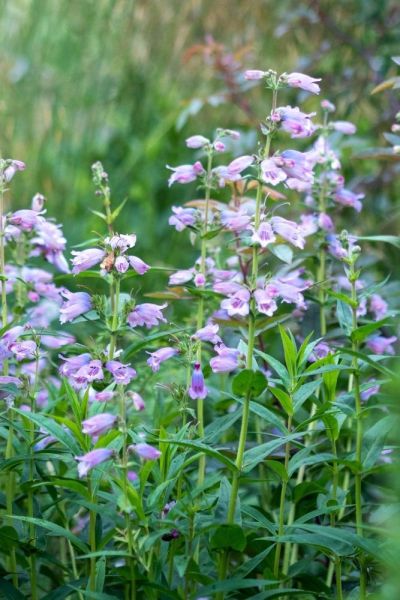
Penstemons come in a wide range of colours and are amongst the most long-lasting perennial flowers.
Penstemon ‘Stapleford Gem’ is hardy in winters down to around -10C, so will survive most UK winters. That’s a USDA hardiness zone of 8/9.
Euphorbias – for interesting shapes
Amicia thinks that euphorbias ‘are not an obvious choice’ when you’re thinking about a long flowering presence in the border. ‘But they’re interesting shapes and they’re leafy. When people start gardening, they just want endless flowers, but the more you garden, the more you realise that contrasting leaf shapes are really important.’
But euphorbias do flower and their flowers last a long time. Amicia mentions two euphorbias at Doddington. In both my garden and at Doddington, Euphorbia characias ‘Wulfenii’ (Mediterranean spurge) has been flowering since the spring and is just going over at mid-summer.
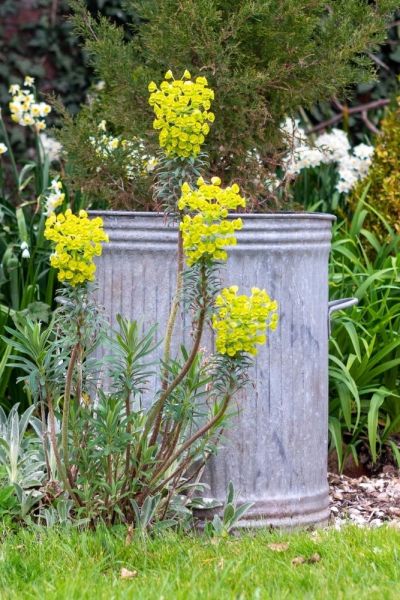
This is Euphorbia ‘Wulfenii’ in my garden, where it self-seeds happily. Its bright citrus flowers last for months in spring.
Euphorbias spread and self seed easily, but most euphorbias are not considered invasive.
Euphorbia characias ‘Wulfenii’ for spring and early summer flowers
I usually just refer to it as Euphorbia ‘wulfenii’ or even just ‘Wulfenii’.
Wulfenii is a very easy-going plant and self seeds around my garden. It has handsome blue-grey leaves and large citrus yellow-green flowers. Although it is usually described as needing ‘full sun’ I have a patch in a shady corner of my garden. It seems to be very happy there.
It grows in a wide range of soils and gets to about 1.5 metres high. Wulfenii can survive winters down to about -10 C (approximately USDA hardiness zones 8/9).
Apart from dead-heading the flowers when they’re over, Wulfenii seems to need very little care. However, all plants benefit from a layer of garden compost or well-rotted manure around their roots once a year.
A long-flowering later-season euphorbia
Wulfenii’s job supplying sculptural citrus yellow-green flowers in the border at Doddington Place Gardens is taken over by Euphorbia ceratocarpa (Horned spurge). This flowers from mid-summer to mid autumn. And the RHS says that in mild conditions ‘it can flower almost all year round.’
Euphorbia ceratocarpa can be planted in west, east or south facing positions and it prefers full sun. It has an RHS Award of Garden Merit, awarded to plants that are exceptional.
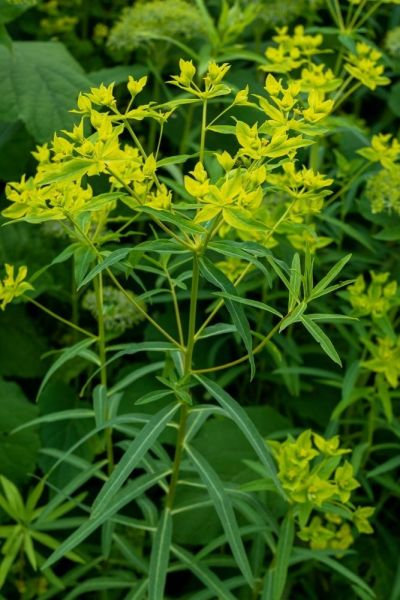
Euphorbia ceratocarpa (Horned spurge) flowers all year in mild climates.
It’s happy on a wide range of soils and, like Wulfenii, can handle winter cold down to about -10 Celsius. So it survives most UK winters, although it may get some dieback in a harsh winter or cold soils. ( USDA hardiness zone of 8/9).
Hardy geraniums – one of the best long-lasting perennial flowers
Amicia’s third pick for perennial flowers that last a long time was hardy geraniums.
There are two types of plant known as geraniums in the UK. One type are really called pelargoniums. They come from the hotter European countries and are usually grown in pots here, flowering in the summer. They’re not hardy enough to be left outside in winter.
But hardy geraniums, also known as cranesbills, are planted in borders. They are related to pelargoniums but both the flowers and leaves look different. Hardy geraniums survive even quite harsh winters. Many can cope with winters that drop to -20C (USDA hardiness Zones 4-9).
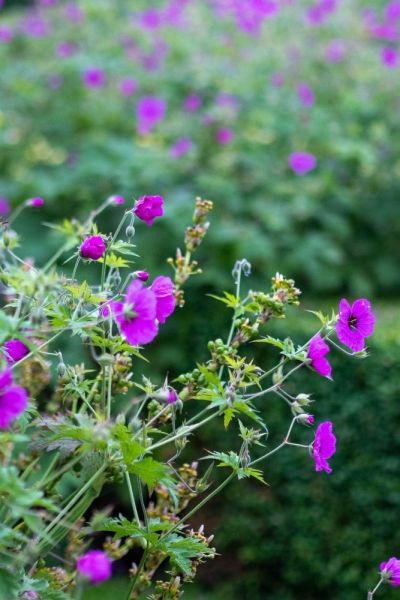
Armenian cranesbill (Geranium psilostemon) flowers from early summer until late summer, then flowers again if you cut it back.
Depending on the variety you choose, some hardy geraniums do very well in shade. All are easy-care. Cut them back once the flowers are over and you usually get a second flush of flowers. Hardy geraniums also often survive drought well, and do well in most soils unless they’re very water-logged.
Some favourite hardy geraniums work well for the front of a border or as ground cover plants, because they only grow to around 18″ or 0.5 metre. For example, Geranium macrorrhizum (Rock cranesbill) is one of the plants mentioned for ground cover in my 10 low maintenance plants post.
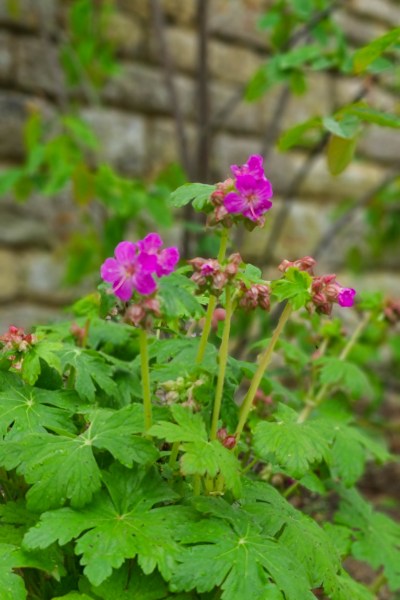
Geranium macrorrhizum – perennial flowers which provide good ground cover for a shady spot, flowering for months at a time.
Geranium psilostemon – for height and bright spots of colour
Amicia identified Geranium psilostemon or Armenian cranesbill, which was bouncing round the borders with vivid magenta flowers. ‘It grows quite high,’ says Amicia, ‘but it’s also quite floaty, so it’s very good plant for a border.’
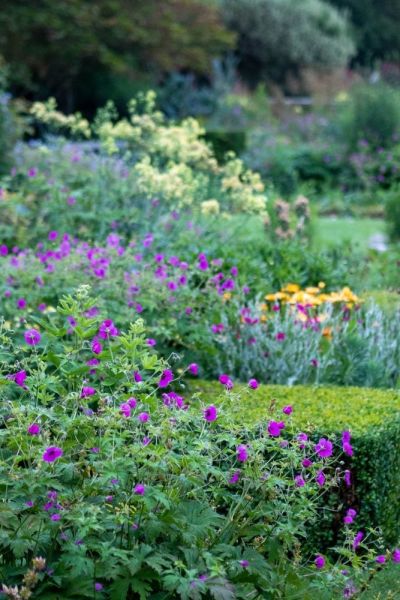
Geranium psilostemon floats in a magenta cloud in the borders in the Sunk Garden.
Geranium psilostemon is quite a tall geranium, so it may need staking. But in Doddington Place’s Sunk Garden it’s propped up by the plants around it in some places. Where it is close to the front of the border, they make supports out of birch twigs so that it looks natural.
You need to cut it back once the first flush of flowers is over. Then you will get a second flush. ‘But this can leave a gap in the border between flowerings,’ says Lucy Adams. ‘So it’s a good idea to have some annuals to plant in the gap. They’ll add colour while the geranium is growing for its second flowering.’
‘We have quite a lot of dahlias,’ adds Amicia. ‘Geranium psilostemon looks very good with dahlias.’ It also has an RHS Award of Garden Merit.
Perennial flowers – The Head Gardener’s Choice
Lucy Adams, head gardener at Doddington Place Gardens, loves astrantias (otherwise known as masterwort).
‘There’s a huge variety of astrantias. We’ve got quite a few pink ones here, such as Astrantia ‘Claret’ and ‘Roma’. They hold their flowers really well.
Astrantias carry on flowering from late spring through to early summer. ‘Then once they’ve flowered, you can dead-head them and you’ll get a second flowering. They grow into good-sized clumps quite quickly.’
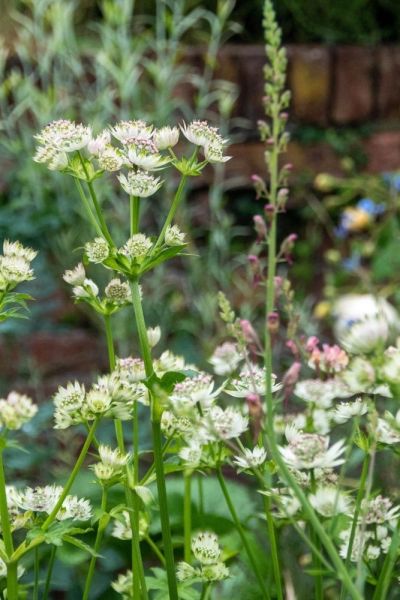
Astrantia Billion of Stars
Lucy says astrantias like a fairly rich soil, but they’re happy in well drained soil.
Looking up the advice on growing astrantias, I found widespread recommendations to grow them in a ‘moist, well-drained soil.’
Personally, I have always found this recommendation confusing. Plants that need a well-drained soil are often happy to withstand a drought. Plants that need moist soils want plenty of water. They won’t do well in drought.
However, astrantias grow well at Doddington, in East Kent, UK. Rainfall is low here – just 26″ a year. So while astrantias wouldn’t be suitable for gravel or ‘dry’ gardens, I think they are resilient enough to cope with slightly drier areas. They’re also very winter-hardy, down to -20C (USDA zones 4-9).
Astrantia major ‘Claret’ for rich wine-red dazzle
There are several clumps of different astrantias at Doddington Place, but Astrantia ‘Claret’ is one of Lucy’s favourites. ‘It grows in sun and partial shade and on most kinds of soil.’
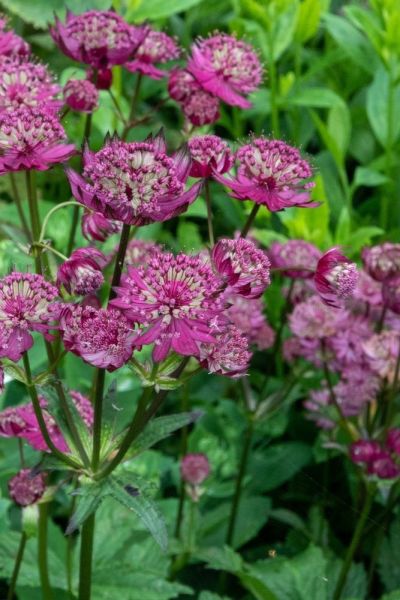
Astrantia major ‘Claret’ at Doddington Place Gardens.
Make sure you add a layer of garden compost or well rotted manure around the roots of astrantia once a year. ‘We add ours in the spring,’ says Lucy. ‘Then it acts as a weed suppressant as well.’
If you have a problem with deer eating your plants, some people say that astrantias are deer resistant. However, as Rosy Hardy says in Perennials Made Simple, ‘you’ll always find someone who says that a deer, rabbit or slug has eaten a plant which was supposed to be resistant.’
Knautia macedonica – Macedonian scabious
Knautia flowers from June to September with rich, deep crimson flowers that look like scabious. It’s loved by bees and pollinators.
Lucy Adams picked this because she says it’s an easy plant to grow, ‘although it does have a sprawling habit, so not a plant for the front of a border.’
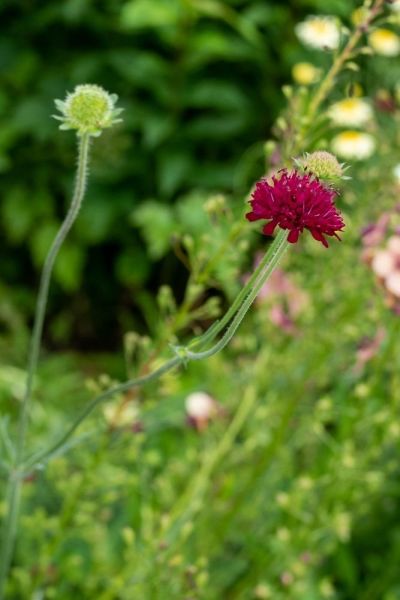
Clouds of small pin-cushion flowers in deep red – Knautia macedonica attracts bees and butterflies
She adds that if you do want it in the front of the border, she would recommend giving it a ‘Chelsea chop.’ That means cutting it down by half in late spring – around the middle of May in the UK. Or you can create a birch twig support for it ‘and let it weave its way through.’
Checking this on the RHS website, I see that it’s considered generally disease-free. However, one garden designer friend of mine has found that it’s prone to mildew.
It’s another very hardy perennial and can survive winters down to -20C (USDA zones 5-9). Knautia self-seeds, according to many people, but it’s not listed as invasive in the UK, the US or Australia.
Roses – there’s a reason why they’re so popular…
My third recommendation is quite predictable, says Lucy. If you want perennial flowers that go on and on in your border, then roses are a must. ‘If you get one of the modern herbaceous roses, they’re repeat flowering. They go well in a herbaceous border. They also look good on their or as a backdrop.’
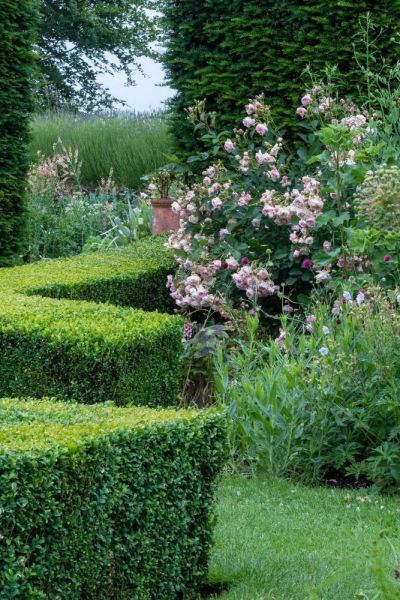
Rose ‘Felicia’ is happy with any aspect, so it makes a good rose to repeat on three sides of the Sunk Garden.
Roses really are the perennial flowers that go on and on. ‘As long as you keep dead-heading, you’ll have flowers all summer long.’
To find out more about growing roses, here’s a post with advice from Neil Miller, head gardener of Hever Castle Gardens on growing roses.
Generally, however, you can find roses for every kind of soil type or position in the garden. There are even roses that can withstand temperatures down to -30C in winter, although you will have to hunt for them. Roses can also grow in Mediterranean or hot climates.
Rose ‘Felicia’ – a long-lasting shrub rose for herbaceous borders
If you want to grow roses in a mixed herbaceous border, Lucy suggests you choose a modern shrub rose, like ‘Felicia’. ‘It has an amazing scent. And it flowers from early summer for about two months, then there’s a bit of down time, after which it comes back, flowering until the autumn.’
Felicia is a pretty pink rose, planted on either side of the steps and entrances on three sides of the Sunk Garden at Doddington Place Gardens. It can grow in sun or partial shade and is happy with a North, South, East or West facing position. This means it can grow equally well in different parts of your garden.
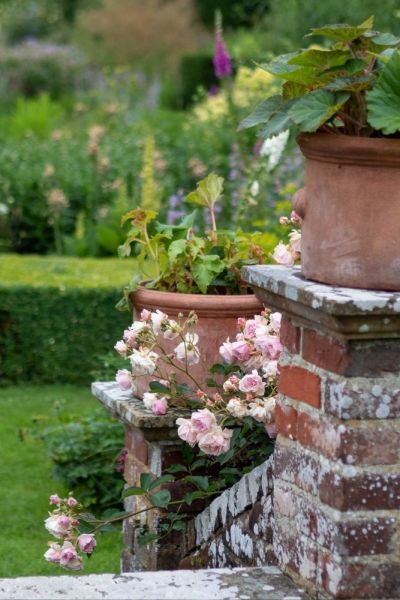
Rose ‘Felicia’ is on either side of the steps and entrances. It has a magical scent, which you can enjoy as you go in and out of the Sunk Garden.
It’s quite a large shrub – 5ft or 150cm tall. So it’s good for the back of a border or to frame entrances.
Lucy has two good tips for those wanting to grow roses in a herbaceous border. ‘Feed them with a seaweed feed four times a year,’ she says. ‘And when you’re pruning them, leave high enough so they’re not overwhelmed by the taller plants in the border.’
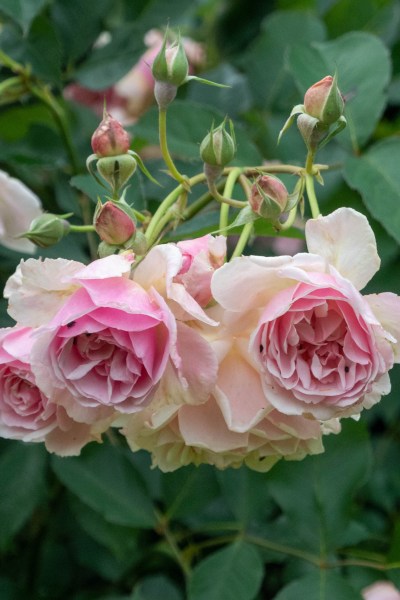
A close up of Rose ‘Felicia.’
Bonus perennial flowers – Anthemis tinctoria
I couldn’t resist adding this cheery yellow flower, so this one is my choice rather than Amicia’s or Lucy’s. It’s known as Golden marguerite and it’s a member of the astor family. It’s easy to grow and spreads quickly, but isn’t considered invasive.
Anthemis tinctoria is very drought-tolerant, once it’s established. If you keep dead heading, it will flower for around three months from mid-summer.
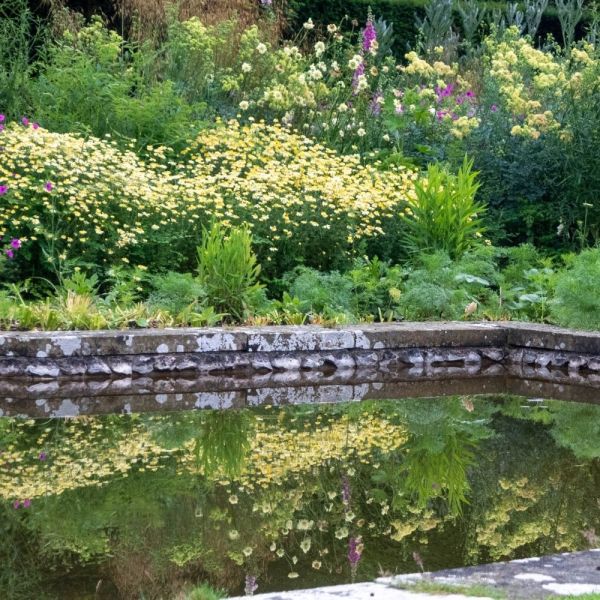
Clouds of Golden marguerite (Anthemis tinctoria) reflected in the pond in the Sunk Garden. These are short-lived perennial flowers, but spread into glorious clumps.
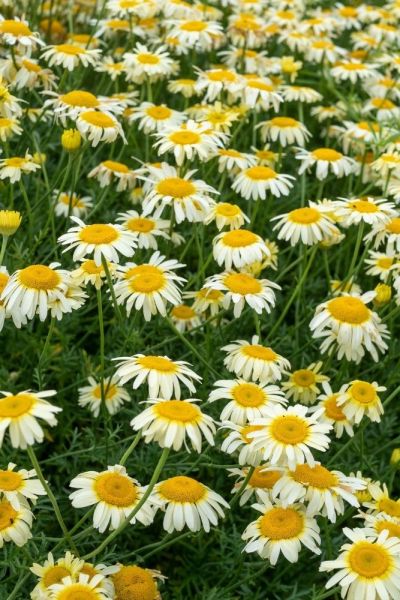
Anthemis tinctoria or Dyer’s chamomile.
Repeat plants for a successful border…
‘In my opinion, successful borders repeat plants,’ says Amicia. ‘We don’t repeat the plants in formal patterns but we have four squares of border around the pond in the Sunk Garden. And we have repeats of the same plants in each border.’
‘Then we add in some pops of colour – a few different plants – in each border, too.’

More brilliant borders advice…
Salvias are also wonderfully long flowering plants for your borders. See here for expert tips on growing salvias.
See here to find out how garden designers plan a border. And here you can get tips on planting a border like a pro – you’ll find some important principles on how to balance out the different plant heights and structures.
There’s more help from Doddington Place Gardens too, if you’re wanting to plant spring bulbs so they look their best.
If you want to get the best from border colour, then dahlias are a brilliant late-summer flower. The more you pick, the more you get and they keep going until the first frosts. Find out about growing dahlias here. And if you’re not growing dahlias because you don’t want to have to dig them up at the end of the summer, find out why I don’t dig up my dahlias here.
If you do get a very difficult summer, like the summer of 2022 which had a record breaking heat wave and drought, here is some good advice on what to do if you think your plants are dying.
See more of Doddington Place Gardens in the video:
You can see more views of this beautiful garden on the video of this post.
Pin to remember perennial flowers that last all summer
And do join us for a free weekly email with more tips, ideas and inspiration for your garden. Sign up here.


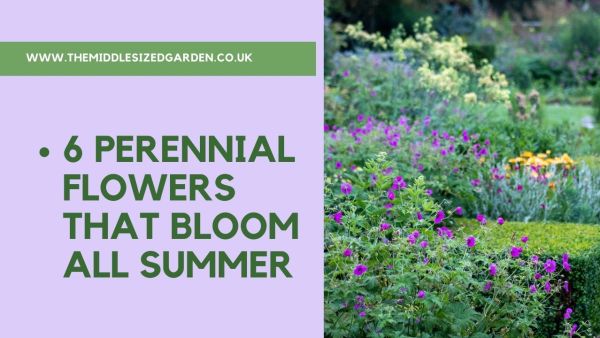























First of all, thank you for your wonderful videos and website.
I have two varieties of Astrantia, a pale pink and a darker red/pink. Both were given to me from a friend’s garden.
The pale pink one is an absolute thug and spreads everywhere via underground runners whereas the darker one has formed a beautiful clump and is well behaved. The “perfume” from the pale pink is also rather unpleasant. So whilst these are attractive plants, I would second your advice to choose the variety carefully….and be wary of free gifts from friends!
That’s interesting! Thank you.
Love your content always. My question is: what are the options you consider when the plant you want is hard to find or not available? Example, I want the echinacea Fragrant Angel which is highly rated for pollinators in 2 separate research results. Can’t find it locally only thru one on line source. Thanks for any tips.
Oh, that is difficult and I sympathise. And getting plants from one country to another is getting harder, as countries get ever more bio-secure (quite rightly, I suppose!). Depending on the rules where you live, you may be able to get a friend to post you some seeds (it’s very difficult to transport live plants legally in most places). Otherwise, there is probably only finding another variant. But it may be worth talking to a local perennial nursery and seeing if they have any ideas. A garden centre won’t know, but someone who grows the plants they sell may be interested and able to help. Sorry this doesn’t have any very specific answers!
Interesting types information
Thank you!
That’s a great help lovely perennials I have some but not all. I will have to purchase some more
Sallyt
Me, too, I think!
Great choice! So reliable
Thank you!